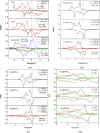The structural, magnetic and optical properties of TMn@(ZnO)42 (TM = Fe, Co and Ni) hetero-nanostructure
- PMID: 29184077
- PMCID: PMC5705660
- DOI: 10.1038/s41598-017-16532-w
The structural, magnetic and optical properties of TMn@(ZnO)42 (TM = Fe, Co and Ni) hetero-nanostructure
Abstract
The magnetic transition-metal (TM) @ oxide nanoparticles have been of great interest due to their wide range of applications, from medical sensors in magnetic resonance imaging to photo-catalysis. Although several studies on small clusters of TM@oxide have been reported, the understanding of the physical electronic properties of TMn@(ZnO)42 is far from sufficient. In this work, the electronic, magnetic and optical properties of TMn@(ZnO)42 (TM = Fe, Co and Ni) hetero-nanostructure are investigated using the density functional theory (DFT). It has been found that the core-shell nanostructure Fe13@(ZnO)42, Co15@(ZnO)42 and Ni15@(ZnO)42 are the most stable structures. Moreover, it is also predicted that the variation of the magnetic moment and magnetism of Fe, Co and Ni in TMn@ZnO42 hetero-nanostructure mainly stems from effective hybridization between core TM-3d orbitals and shell O-2p orbitals, and a magnetic moment inversion for Fe15@(ZnO)42 is investigated. Finally, optical properties studied by calculations show a red shift phenomenon in the absorption spectrum compared with the case of (ZnO)48.
Conflict of interest statement
The authors declare that they have no competing interests.
Figures






Similar articles
-
Electronic and Magnetic Properties of Ni-Doped Zinc-Blende ZnO: A First-Principles Study.Nanomaterials (Basel). 2018 Apr 26;8(5):281. doi: 10.3390/nano8050281. Nanomaterials (Basel). 2018. PMID: 29701687 Free PMC article.
-
Fabrication and characterization of a diluted magnetic semiconducting TM co-doped Al:ZnO (TM=Co, Ni) thin films by sol-gel spin coating method.Spectrochim Acta A Mol Biomol Spectrosc. 2013 Apr;106:118-23. doi: 10.1016/j.saa.2013.01.017. Epub 2013 Jan 19. Spectrochim Acta A Mol Biomol Spectrosc. 2013. PMID: 23396005
-
Co-Tetraphenylporphyrin (co-TPP) in TM-TPP (TM = Fe, Co, Ni, Cu, and Zn) series: a new optical material under DFT.J Mol Model. 2018 Aug 18;24(9):239. doi: 10.1007/s00894-018-3783-8. J Mol Model. 2018. PMID: 30120570
-
Structural and electronic properties of TM(n)[(BN)(3)H(6)](m) complexes with TM = Co (n, m = 1-3) and with TM = Fe, Ni, Ru, Rh, Pd (n = m = 1-3).J Phys Chem A. 2014 Apr 24;118(16):2976-83. doi: 10.1021/jp500191v. Epub 2014 Apr 11. J Phys Chem A. 2014. PMID: 24673101
-
Evolution of the structural, energetic, and electronic properties of the 3d, 4d, and 5d transition-metal clusters (30 TMn systems for n = 2-15): a density functional theory investigation.Phys Chem Chem Phys. 2017 Jun 14;19(23):15484-15502. doi: 10.1039/c7cp02240a. Phys Chem Chem Phys. 2017. PMID: 28580970
Cited by
-
Metal Nanoparticles Obtained by Green Hydrothermal and Solvothermal Synthesis: Characterization, Biopolymer Incorporation, and Antifungal Evaluation Against Pseudocercospora fijiensis.Nanomaterials (Basel). 2025 Feb 28;15(5):379. doi: 10.3390/nano15050379. Nanomaterials (Basel). 2025. PMID: 40072182 Free PMC article.
-
Role of Dispersion Interactions in Endohedral TM@(ZnS)12 Structures.ACS Omega. 2021 Jun 17;6(25):16612-16622. doi: 10.1021/acsomega.1c02016. eCollection 2021 Jun 29. ACS Omega. 2021. PMID: 34235333 Free PMC article.
References
-
- Silva JLD, et al. J. Sauer, Formation of the cerium orthovanadate Ce V O 4: DFT + U study. Physical Review B. 2007;76:125117. doi: 10.1103/PhysRevB.76.125117. - DOI
-
- Beltrán J, et al. Magnetic properties of Fe doped, Co doped, and Fe + Co co-doped ZnO. Journal of Applied Physics. 2013;113:17C308. doi: 10.1063/1.4799778. - DOI
LinkOut - more resources
Full Text Sources
Other Literature Sources

